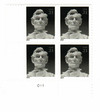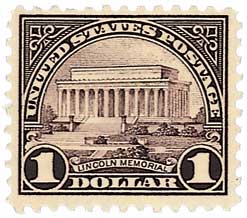
# 4860 PB - 2014 21c Lincoln Memorial
City: Springfield, IL, Lincoln’s home before becoming President
Printed By: CCL Label Inc.
Printing Method: Photogravure printed in sheets of 3 panes of 20 per sheet
Perforations: Serpentine Die Cut 11
Self-Adhesive
Dedication Of Lincoln Memorial
In 1860, Leonard Volk made plaster masks of Abraham Lincoln’s face and hands. Two days earlier, the Illinois lawyer had learned he was the Republican Party’s presidential nominee. Neither man could have known Lincoln would be assassinated five years later or that Volk’s casts would be used to create a monument to the fallen leader.
Plans for a national monument to Abraham Lincoln were discussed as early as 1867. However, the post-Civil War Reconstruction and the search for an appropriate location took decades. In 1914, on Lincoln’s 105th birthday, the first stone was laid.
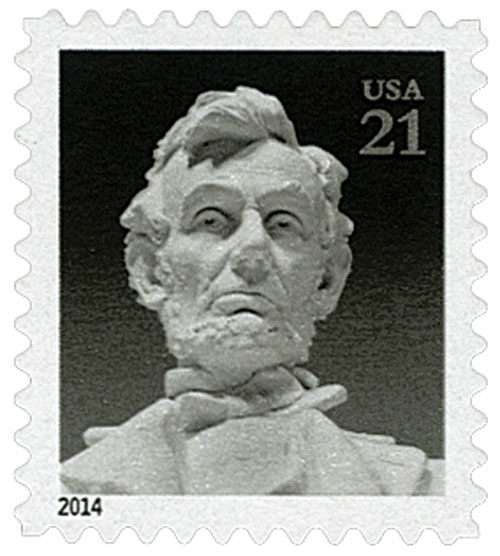
The monument was dedicated eight years later on May 30, 1922, with Lincoln’s only surviving child, Robert Todd Lincoln, in attendance. Per President Warren G. Harding’s instructions, the Military Order of the Loyal Legion of the United States (MOLLUS) coordinated the dedication ceremonies that day, and has arranged all commemorations there since (usually held on Lincoln’s birthday, February 12.)
Some 50,000 people were present for the ceremony, which was presided over by former President and then Chief Justice of the U.S. Supreme Court, William Howard Taft. Previously, Taft had led the commission that arranged for the memorial’s creation.
The keynote speaker of the dedication was Dr. Robert Russo Moton, president of the Tuskegee Institute. Speaking the largely white and segregated audience, Moton asked the audience to seriously consider Lincoln’s hope for a “new birth of freedom.” Then President Harding addressed the crowd, a speech that was broadcast on an experimental radiophone created by the U.S. Navy.
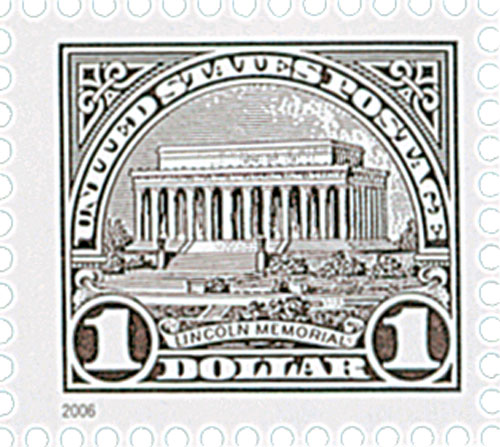
Modeled after the Temple of Zeus at Olympia, the monument features a marble statue of Lincoln’s solitary figure deep in thought. Volk’s masks were used to help guide the work, which occurred under the direction of sculptor Daniel Chester French.
Rich in symbolism and grandeur, the Lincoln Monument features 36 large columns (representing the 25 U.S. states in the Union at the time of Lincoln’s death plus the 11 seceded Confederate states). The remaining 14 states are also honored (a plaque was added in honor of Alaska and Hawaii in 1959). Architect Henry Bacon designed the memorial in the style of a Greek temple – a show of respect for the President considered a hero to many.
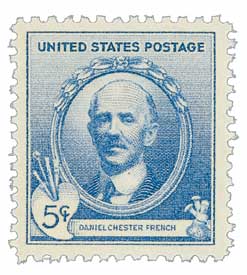
Inside the memorial resides the colossal statue of a tired, pensive Lincoln. Designed by Daniel Chester French, the statue of Lincoln is seated in a Roman-style chair, a symbol of authority for the ages.
Original specifications called for Lincoln’s statue to be less than ten feet tall. Realizing the building would dwarf it; the height was increased to nearly 19 feet. The pedestal underneath adds almost ten feet, making Lincoln’s likeness the focal point of the memorial. Plans to enclose the interior were then abandoned.
The sculpture has fascinated visitors for decades, both for its lifelike representation of Lincoln as well as a pair of legends about its design. One legend claims that French sculpted a likeness of Confederate General Robert E. Lee’s face in a flourish of hair on the back of Lincoln’s head. (Click here to see and decide for yourself.)
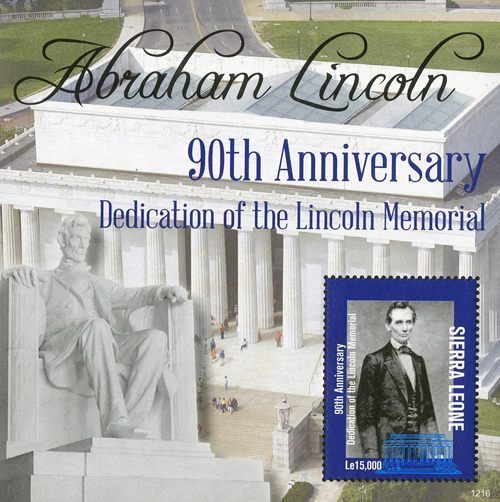
Another legend claims that French sculpted the hands to spell out Lincoln’s initials in sign language, with his left hand forming the letter “A” and his right hand the letter “L.” While there is no evidence that this was French’s intention, some historians believe there is a connection. In 1864, President Lincoln signed the federal legislation granting Gallaudet University (a school for the deaf) the authority to grant college degrees.
Within the walls of the Lincoln Memorial are two of Lincoln’s speeches inscribed on the walls – the Gettysburg Address and a portion of his second inaugural address.
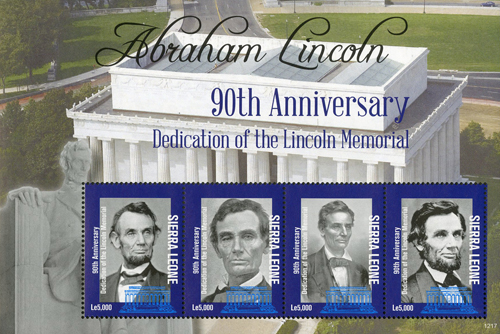
Since 1922 Lincoln’s statue has overseen landmark events of the Civil Rights Movement such as Marian Anderson’s historic concert and Martin Luther King’s “I Have a Dream” speech.
Click here to view video of the dedication ceremony.
City: Springfield, IL, Lincoln’s home before becoming President
Printed By: CCL Label Inc.
Printing Method: Photogravure printed in sheets of 3 panes of 20 per sheet
Perforations: Serpentine Die Cut 11
Self-Adhesive
Dedication Of Lincoln Memorial
In 1860, Leonard Volk made plaster masks of Abraham Lincoln’s face and hands. Two days earlier, the Illinois lawyer had learned he was the Republican Party’s presidential nominee. Neither man could have known Lincoln would be assassinated five years later or that Volk’s casts would be used to create a monument to the fallen leader.
Plans for a national monument to Abraham Lincoln were discussed as early as 1867. However, the post-Civil War Reconstruction and the search for an appropriate location took decades. In 1914, on Lincoln’s 105th birthday, the first stone was laid.

The monument was dedicated eight years later on May 30, 1922, with Lincoln’s only surviving child, Robert Todd Lincoln, in attendance. Per President Warren G. Harding’s instructions, the Military Order of the Loyal Legion of the United States (MOLLUS) coordinated the dedication ceremonies that day, and has arranged all commemorations there since (usually held on Lincoln’s birthday, February 12.)
Some 50,000 people were present for the ceremony, which was presided over by former President and then Chief Justice of the U.S. Supreme Court, William Howard Taft. Previously, Taft had led the commission that arranged for the memorial’s creation.
The keynote speaker of the dedication was Dr. Robert Russo Moton, president of the Tuskegee Institute. Speaking the largely white and segregated audience, Moton asked the audience to seriously consider Lincoln’s hope for a “new birth of freedom.” Then President Harding addressed the crowd, a speech that was broadcast on an experimental radiophone created by the U.S. Navy.

Modeled after the Temple of Zeus at Olympia, the monument features a marble statue of Lincoln’s solitary figure deep in thought. Volk’s masks were used to help guide the work, which occurred under the direction of sculptor Daniel Chester French.
Rich in symbolism and grandeur, the Lincoln Monument features 36 large columns (representing the 25 U.S. states in the Union at the time of Lincoln’s death plus the 11 seceded Confederate states). The remaining 14 states are also honored (a plaque was added in honor of Alaska and Hawaii in 1959). Architect Henry Bacon designed the memorial in the style of a Greek temple – a show of respect for the President considered a hero to many.

Inside the memorial resides the colossal statue of a tired, pensive Lincoln. Designed by Daniel Chester French, the statue of Lincoln is seated in a Roman-style chair, a symbol of authority for the ages.
Original specifications called for Lincoln’s statue to be less than ten feet tall. Realizing the building would dwarf it; the height was increased to nearly 19 feet. The pedestal underneath adds almost ten feet, making Lincoln’s likeness the focal point of the memorial. Plans to enclose the interior were then abandoned.
The sculpture has fascinated visitors for decades, both for its lifelike representation of Lincoln as well as a pair of legends about its design. One legend claims that French sculpted a likeness of Confederate General Robert E. Lee’s face in a flourish of hair on the back of Lincoln’s head. (Click here to see and decide for yourself.)

Another legend claims that French sculpted the hands to spell out Lincoln’s initials in sign language, with his left hand forming the letter “A” and his right hand the letter “L.” While there is no evidence that this was French’s intention, some historians believe there is a connection. In 1864, President Lincoln signed the federal legislation granting Gallaudet University (a school for the deaf) the authority to grant college degrees.
Within the walls of the Lincoln Memorial are two of Lincoln’s speeches inscribed on the walls – the Gettysburg Address and a portion of his second inaugural address.

Since 1922 Lincoln’s statue has overseen landmark events of the Civil Rights Movement such as Marian Anderson’s historic concert and Martin Luther King’s “I Have a Dream” speech.
Click here to view video of the dedication ceremony.



